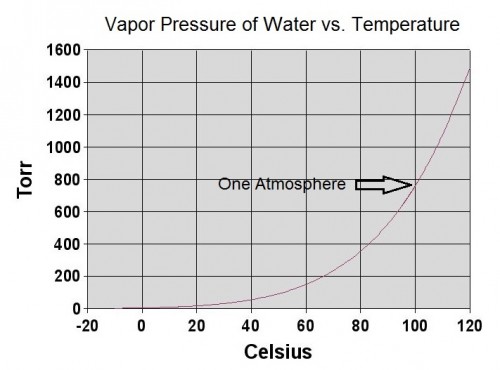In the preceding blog, we learned that relative humidity of air is affected by temperature. Although I really didn’t say it, I’m sure readers have come to the conclusion that lower relative humidity will result in air which is “hungry” for water. Air that is at a low relative humidity, then, is beneficial to drying. Higher temperature = lower relative humidity. Lower relative humidity = faster drying. But there is also another potential benefit to increased temperature in drying.
Vapor Pressure –
Vapor pressure, in simple terms, is the equilibrium pressure over a liquid in an enclosed space. A thorough explanation of the whole thing about vapor pressure is a little complex and won’t contribute to our discussion here so let’s just cut to the graph.

Liquids become more volatile as their temperature is increased. More volatile means that evaporation will occur at a faster rate thereby speeding the drying process. When the vapor pressure of a liquid reaches that of atmospheric pressure, the liquid boils. It is important to point out that this all depends on the temperature of the liquid and NOT the temperature of the air surrounding it as was the case with relative humidity. And this does make a difference.
Note – Before proceeding let me say that the astute reader may already have deduced that vapor pressure is what vacuum drying is all about. Yes, that is correct. But, for now, I’ll just talk about it in terms of more conventional drying and leave the vacuum drying discussion for a later blog. OK? – Thanks
Liquid on a part is usually in a relatively thin layer compared to the geometry of the part being dried. Because of this, the temperature of the liquid on a part is usually at or near the temperature of the part rather than to the temperature of the surrounding air. It’s all about conduction and thermal mass – air simply does not conduct heat as readily as do most solids and liquids. In order to benefit from the increase in vapor pressure due to increased temperature, a way must be found to increase the temperature of the liquid and, usually, this means raising the temperature of the part. Unfortunately, using the hot air in a dryer is not a very effective way to increase the temperature of the part for this and a couple of other reasons which we will discuss later. Introducing the part to the dryer at an elevated temperature or using radiant heating are much more effective ways to accomplish this goal.
OK, so we all agree that heat is good for the overall drying process. But there are some downsides as well. Many parts will not tolerate high temperatures. Plastics, for example, may become deformed if heated above what would be considered a “moderate” drying temperature of 150F. Many metals will become discolored or experience rapid oxidation at high temperatures. So, basically, the sky may not be the limit when it comes to increasing temperature to enhance drying. Drying, in fact, is an art. There are a surprisingly large number of variables involved. Upcoming blogs will discuss these variables and how to achieve an effective drying process in more detail.
– FJF –



 English
English Spanish
Spanish Chinese
Chinese Canada
Canada Mexico
Mexico United Kingdom
United Kingdom



